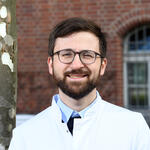New PI strengthens exchange between MDC and Charité
When Dr. Michael Sigal studied medicine, he discovered he was fascinated by how the human body is so precisely regulated, a perfect machine.
This is why I not only wanted to be a doctor treating patients. I always had the desire to study and understand how things function and what mechanisms are responsible for causing dysfunction.
“This is why I not only wanted to be a doctor treating patients,” says Sigal, attending physician at Charité specializing in gastroenterology. “I always had the desire to study and understand how things function and what mechanisms are responsible for causing dysfunction.”
Sigal is launching a junior research group “Gastrointestinal barrier, regeneration and carcinogenesis” at the Berlin Institute for Medical Systems Biology (BIMSB), which is part of the Max Delbrück Center for Molecular Medicine in the Helmholtz Association (MDC). He will maintain his post at Charité’s Medical Department, Division of Hepatology and Gastroenterology and be welcomed as a guest PI, sharing lab space, equipment and interacting closely with MDC teams.
Gut reaction
Sigal studies the gastrointestinal (GI) tract’s epithelium, cells lining the stomach and intestine that provide a critical barrier between our bodies and the outside world. “The gut epithelium has incredible regenerative capacity: every week, about 300 grams of epithelial cells are being shed and replaced by stem cells,” Sigal says. “It’s the highest turnover rate of all tissues in the human body.”
Sigal is particularly interested in how the regeneration process works, and how interactions with regular microbiota and infectious bacteria contribute or throw off the process, ultimately leading to inflammatory bowel diseases and cancer. “Every gastrointestinal disease from the stomach and the gut is also a disease of the epithelium,” he says.
Cross-section of gastric epithelium (mouse model): Helicobacter pylori bacteria (green) colonize the gastric glands. Gastric epithelial cell nuclei are shown in blue, their cytoskeleton in red.
Already he has found unexpected links. During a two-year research post at Stanford University, he and colleagues discovered that Helicobacter pylori, which colonizes the stomachs of about 50% of the world’s population, can directly interact with the stomach’s epithelial stem cells, and this led to their dysregulation and ultimately development of gastric diseases.
A doctor and a researcher
Sigal, who has recently completed the three-year BIH Charité Clinician Scientist Program splits his time between seeing patients and conducting basic research. He finds this dual perspective is a major benefit in both roles. As a physician, he sees first-hand what challenges need to be addressed. “There is so much in the clinic that is not well understood,” he says. “Why do diseases occur? Why do some patients respond to medications while others do not?” As a trained researcher, he takes those questions to the lab. Insights from basic research can then, ideally, guide patient treatment.
A critical bridge
In 2019, Sigal received an Emmy Noether Program grant from the German Research Foundation (DFG) to head his own research group. While officially based out of Charité, he and his six researchers will now also have lab space at MDC’s BIMSB, which is just across the street from Charité in the Mitte borough of Berlin.
He is excited to take his research to the next level, leveraging BIMSB’s equipment and expertise in bioinformatics, single cell, computational and spatial analyses to understand how cells communicate with each other. “We will be able to get much deeper insights into how the epithelium functions,” Sigal says. “BIMSB is ideal for this because many groups are looking at cell regulation and applying tools that allow resolving cellular processes in a tissue at single cell level, which has not been possible so far and is only practiced at such a high level in a few places worldwide"..”
I think we can learn a lot from each other. Interdisciplinarity is what will bring real innovation.
Likewise, he hopes his GI epithelium research system and clinical perspective will interest and benefit MDC colleagues. For example, he says his system is a good fit to study how diseases develop long before they manifest later in life as cancer. “I think we can learn a lot from each other,” he says. “Interdisciplinarity is what will bring real innovation.”
The place to be
Sigal is a big advocate for increasing collaboration between the two institutions. He anticipates just being in the same building will lead to surprising discussions and new ideas, and feels that the collaboration between MDC and Charité is just one example of how the city is building its culture of open scientific exchange.
Text: Laura Petersen
Further information
- Emmy Noether-Programme by the DFG
- How gastric stem cells fight bacteria (Charité press release)
- Searching for dangerous gut bacteria (Charité press release)





